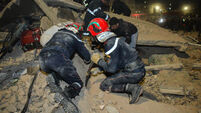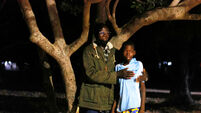Residents count cost of cyclone battering
A powerful cyclone ripped across Australia’s north-east coast, blasting apart houses, laying waste to banana crops and leaving boats lying in the streets of wind and wave-swept towns.
Emergency services fanned out as day broke to assess the damage across a disaster zone stretching more than 190 miles in Queensland state, using chainsaws and other equipment to cut through trees and debris blocking roads.
State premier Anna Bligh said no deaths or serious injuries had been reported but bad news could yet emerge from many places still cut off. Several thousand people were expected to be left homeless, she said.
Cyclone Yasi was moving inland and losing power today, but drenching rains were still falling, adding to a state where Australia’s worst flooding in decades has killed 35 people since late November.
Hundreds of thousands of people spent the night huddled in evacuation centres or in their homes as the storm made landfall, packing howling winds gusting to 186mph and causing tidal surges that swamped coastal areas.
“Nothing’s been spared. The devastation is phenomenal, like nothing I’ve ever experienced,” David Brook, the manager of a resort at Mission Beach, where the core of the storm hit the coast, said.
“Vegetation has been reduced to sticks,” said Sgt Dan Gallagher, a Mission Beach police officer.
At Innisfail, acres of banana trees lay snapped in half, the crops ruined, and power lines had been snapped in half by the winds.
The main road leading south was cut by tidal floodwaters, and hundreds of cars were parked nearby as people who had evacuated yesterday tried to get home to see what was left.
Barbara Kendall and her husband David spent a sleepless night in a parking garage below a supermarket in Innisfail after being evacuated from their coastal home at Kurrimine Beach.
“It was really terrifying, but we were safe,” she said. “It’s a terrifying sound. It’s really hard to describe. All I could hear was the screeching of the wind.
“We haven’t slept for about a week, but we’ve got our house. We’re very lucky, I think – it could have been much worse.”
Towns around Mission Beach were hardest hit. In Tully, a town of 3,500 people, one in three houses were reported to either have been demolished by the storm or had the roof ripped off, Ms Bligh said.
Further south, emergency workers had cut their way into the coastal community of Cardwell and found older houses wrecked and boats pushed up into the town, she said. The entire community was believed to have evacuated before the storm.
Electricity supplies were cut to almost 180,000 houses in the region – a major fruit and sugarcane-growing area and also considered a tourist gateway to the Great Barrier Reef – and police warned people to stay inside until the danger from fallen power lines and other problems was past.
More than 10,000 people in 20 evacuation centres were being told they could not leave yet.
“I’m very relieved this morning, but I do stress these are very early reports,” Ms Bligh said of the information that no-one had been killed overnight. “It’s a long way to go before I say we’ve dodged any bullets.”
Amid the chaos, there was some happy news – a baby girl was born at a Cairns evacuation centre just before dawn with the help of a British midwife on holiday, Cairns councillor Linda Cooper said.
Ms Cooper said the healthy baby, delivered after a three-hour labour, was the second child for Akiko Pruss, a Japanese woman who lives in Cairns with her husband.
The largest towns in the path of the cyclone, including Cairns and Townsville, were spared the worst of the fierce winds. Trees were knocked down, but few buildings were damaged, authorities said. But Townsville was suffering widespread flooding.
Queensland officials had warned people for days to stock up on bottled water and food, and to board or tape up their windows. People in low-lying or exposed areas were told to evacuate. Ms Bligh credited the preparations with saving lives.
Australia’s huge, sparsely populated tropical north is battered annually by about six cyclones – called typhoons throughout much of Asia and hurricanes in the Western hemisphere. Building codes have been strengthened since Cyclone Tracy devastated the city of Darwin in 1974, killing 71 in one of Australia’s worst natural disasters.













